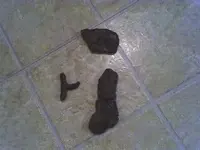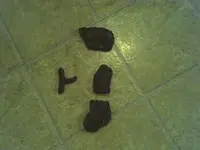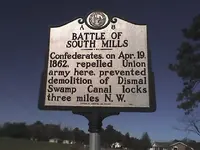Cryptodave,
Here are some things to look for that will help identify possible shell frags:
First here are some examples of shell fragments. They are usually longer and the curve of the shell should be from side to side, but should be straight along the axis of the shell, if that makes sense.
These are cannon ball fragments. The curvature of the wall should extend in all directions. This will be more or less noticable depending on the size of the ball. The wall thickness will vary as well, the frag on the left was a larger ball vs the smaller one on the right. The piece in the middle is the top of a Bormann cannon ball with the iron base plug for the time fuse still intact.
Also check any suspect iron chunks for threaded holes for the fuse to be screwed in. The one on the left is the nose of a Hotchkiss shell. The other is a Parrot shell.
Some shells just have a hole without any threads as the case with this one that used a wood plug.
The base of the shell can help identify it too. The one on the left has a hole on the center for use with a bolt-on sabot like the CS Brooke. The middle is the base cup from the Hotchkiss with three flame grooves, and the right is a Parrot base with the brass sabot still attached.
Finally there are some frags that are shaped specific to the way the projectile was designed, as the case with these Confederate polygonal fragments. The inside of the shell was scored to break apart in these distinct star shapes upon detonation:
Hope these pics will help id your finds, and anybody else who may have some shell fragments stuck back in the junk box!!
D.













